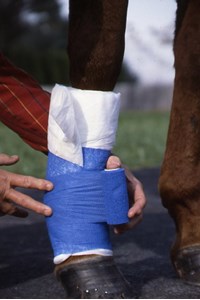Your veterinarian has just sutured your horse’s wound and is headed back down the driveway. The healing process is off to a good start, but now it’s up to you to keep it on track.

In the coming days, your primary goal is to keep the sutures clean and dry. Water can not only carry pathogens into the wound, it can also soften and weaken the suture material, causing it to fail. You’ll need to clean a sutured wound only if it has visible debris on it. To clean the area without soaking it, wipe gently with a dry paper towel or a slightly damp sterile gauze square. Avoid vigorous rubbing.
Sutures to a wound on the lower leg will almost always be bandaged. Not only does the covering protect the wound from dirt, but the wraps stabilize the skin, reducing tension so the edges don’t pull apart again. Your veterinarian will give you specific instructions on how often to change the bandage and how long to keep it up.
As you clean and re-bandage a sutured wound, you’ll need to be vigilant for signs of trouble. Any unexpected changes—such as gaps in the skin, missing sutures, swelling, foul odors or unexpected discharges—warrant a call to your veterinarian. Taking pictures regularly and comparing them can be helpful. The condition of a healing wound can change quickly, so be sure to scrutinize the area at least once a day.
This article first appeared in EQUUS issue #456, September 2015.








